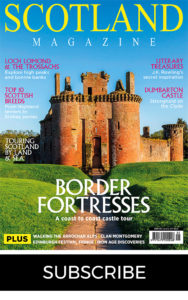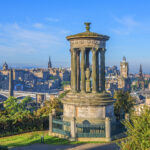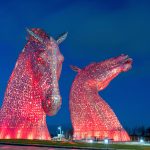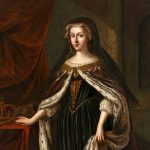MORE FROM SCOTLAND MAGAZINE
The Scottish Isles
By ferry or plane, bridge or causeway, the Scottish Isles are tantalisingly inviting
Words by Sally Coffey
Few places elicit such a sense of longing as the myriad Scottish Isles. From the Western Isles to the Inner Hebrides and the Northern Isles, Scotland has been spoiled with sea-enclosed parcels of land that have yielded unique communities and which are fringed with some of the most wildly beautiful white-sand beaches you’ve ever seen.
By day, the landscapes beckon us to explore. Wildlife sightings in the seas, the hills, and skies are frequent, and when we’ve sated our appetite for adventure, nothing beats returning to the cosy cocoon of our holiday home to warm our feet by the open fire. By night, the ink-black canvas of the sky sparkles with stars, occasionally illuminated to awesome effect by the Aurora Borealis (Northern Lights) – a light show like no other.
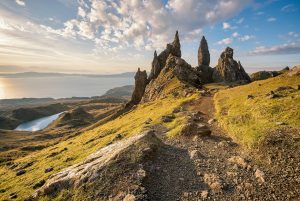
With a well-connected ferry network, largely provided by Caledonian MacBrayne (www.calmac.co.uk), complemented by some unforgettable road and rail routes – Railway Touring (www.railwaytouring.net) runs some luxurious journeys that connect to the islands – getting to these heavenly havens is much easier than one might presume. And once here you need to reset your watch to island time, for nothing needs rushing in the Scottish Isles – here, you have all the time in the world.
Here are 11 of our favourite Scottish Isles
Skye
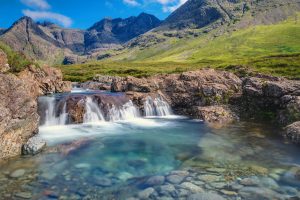
The Isle of Skye tops many a Scotland bucket list and for very good reason. Home to the mighty Cuillin – a jagged mountain range that includes 11 Munros (12 if you include Blá Bheinn, just outside the main ridge) – a ubiquitous sight wherever you go on the isle, its dramatic scenery demands regular sharp intakes of breath. Other landmarks, from the Old Man of Storr to the Fairy Bridge and Fairy Pools (pictured), have spawned legends, but perhaps most enchanting of all, are its quieter, traditional settlements, where you will be welcomed like a prodigal son, and lulled to sleep by Gaelic song.
Where to stay: Hotel Eilean Iarmain in a Gaelic-speaking community in the south of Skye, has comfortable rooms, a decent restaurant, friendly staff, and regular folk music sessions in its wood-panelled pub. eileaniarmain.co.uk
Getting there: Since opening its bridge in 1995, Skye has seen its visitor numbers soar as people can now simply drive over the bridge from Kyle of Lochalsh on the mainland. However, for a real sense of travelling ‘over the sea’ to Skye, the ferry is best, with the route from Mallaig on the mainland to Armadale in south Skye the most popular.
Lewis & Harris
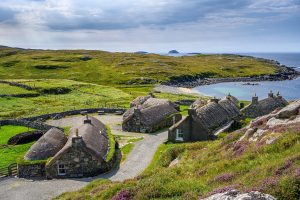
This dual isle – the largest of the Western Isles (also known as the Outer Hebrides) – may be connected by land, but locals feel very much that the two sides are disparate. There certainly are differences. Lewis feels more desolate in places, with large swathes of bogland stretching into the distance, but it is also home to some of the island’s biggest attractions: the Standing Stones of Calanais, Gearrannan Blackhouse Village (pictured), and the famous Uig Sands. Harris on the other hand is hillier, craggier, and just about the most mesmerising place in the world, with the kind of dazzling white beaches lapped by iridescent waters that make you forget about all others. And then there’s the tweed – why buy from a city store when you can visit the homes and workshops of the weavers themselves?
Where to stay: Lots of lovely holiday homes offer creature comforts but for views, homeliness and hospitality, it has to be Scarista House. scaristahouse.com
Getting there: The two main ferry routes are from Uig on Skye to Tarbert on Harris, and Ullapool on the Scottish mainland to Stornoway on Lewis. Loganair runs flights from Inverness and Glasgow to Stornoway. calmac.co.uk; loganair.co.uk
Barra
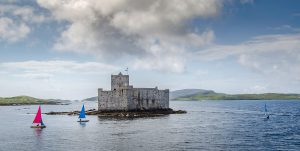
While Lewis and Harris is the most northerly of the Outer Hebridean isles, Barra is way down south in the archipelago. Famed for its clean, empty, sandy beaches, and its ruined castle (Kisimul), for many visitors, the colourful machair of neighbouring Vatersay (the most southerly inhabited isle in the group and accessed by causeway) and the real-life pub that inspired the Whisky Galore tale (reached by a short ferry) are the biggest draws. However, there is one other card up Barra’s gorgeous sleeve: its beach runway. The only beach in the world that receives scheduled flights, this is one of the few occasions where we would recommend arriving by air rather than sea.
Where to stay: Sealladh Na Mara offers simple rooms near the airport, and the beach view is bound to get your day off to a good start. bedinbarra.com
Getting there: Though you can get the ferry here from Oban, flights aboard a small plane from Glasgow take just an hour, making Barra not only one of the easiest islands to reach but provides the thrill of landing on a beach runway.
calmac.co.uk; loganair.co.uk
Mull
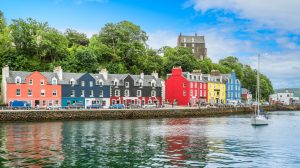
The second largest of the Scottish Isles in the Inner Hebrides and one of its most visited, Mull is green, lush, and very beautiful, with silvery beaches back by rugged hills, vibrant wildflowers, and lots of hidden (and not so hidden) waterfalls, rivers, and lochs – some of which are ideal for a refreshing dip. The colourful main town of Tobermory (left) is quaint yet bustling, with lots of shops to browse, while boat trips run from here to see some of the marine life off Scotland’s west coast. You can even take a sea-eagle tour, to see the majestic birds that have made the island home.
Where to stay: For a cosy self-catering stay with bags of character, check into lochside Fern Cottage. Though be warned: it’s the kind of place you won’t want to leave. boutique-retreats.co.uk
Getting there: The easiest route to Mull is by ferry from Oban on the mainland to Craignure on the east of the isle (50 mins) as Oban is well served by road and rail. Shorter ferry routes from Kilchoan on the Ardnamurchan peninsula direct to Tobermory (35 mins), and Lochaline on the Morvern peninsula to Fishnish (18 mins) do take you a little more off the beaten track. calmac.co.uk
Arran
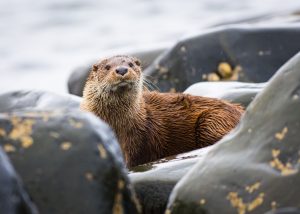
Often described as Scotland in miniature, Arran has a little bit of everything – hills, standing stones, whisky distilleries, ruined castles, craftmakers, independent food producers, and lots of wildlife (right). It’s also one of the most accessible of the Scottish Isles – located in the Firth of Clyde on Scotland’s west coast, it can be reached from Glasgow in just a couple of hours by road and sea, meaning even those who are short of time, or more at home in the city, can enjoy a taste of island life for a day or two.
Where to stay: Auchrannie Resort, near the ferry port of Brodick, has the kind of facilities you wouldn’t expect of an island hotel. There are traditional rooms in the main hotel, luxurious spa resort rooms, and lodges for more privacy. On site there is a spa and pool, a choice of restaurants and a bar, while guests can hire bikes to explore the estate and surrounds, or book an archery session. www.auchrannie.co.uk
Getting there: There are regular direct trains from Glasgow to Ardrossan Harbour from where you can make the Calmac connection to Brodick on Arran. The whole journey should take just two hours.
Shetland Islands
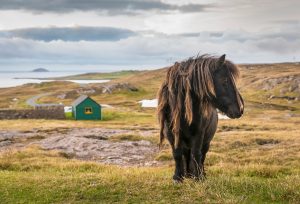
The farthest inhabited of the Scottish Isles is a group distinct from any other. Both its dialect and way of life feel at times more Scandinavian than Scottish, and of course it was ruled for centuries by the Vikings until coming to Scotland in the 15th century, but you’ll find most islanders here consider themselves Shetlanders above all else. Shetland ponies, which have been here centuries, are part of the local landscape, as are the infinite sheep you’ll see, as wool is big business, thanks to the worldwide popularity of the Fair Isle style of knitting. To see Shetland at its best, visit during Wool Week (September) or one of the Up Helly Aa fire festivals, which celebrate the Viking heritage of the isles (Jan-March), when the islands shed their quiet reputation, for a while at least.
Where to stay: There are a limited number of guest houses and hotels throughout the islands, so book early. We love Ortolan B&B, in the main town of Lerwick, which has smart, luxurious rooms in a period house, with warm and personal service. privatehousestays.com/listing/ortolan-house-b-b
Getting there: You can fly to Sumburgh on Shetland Mainland from Glasgow and Edinburgh, but the overnight ferry from Aberdeen gives you the truest sense of how far-flung these isles are.
loganair.co.uk; northlinkferries.co.uk
Orkney Islands
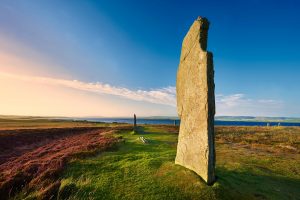
Though not quite as far to reach as the Shetland Islands, the Orkney Islands share the moniker the ‘Northern Isles’ with their neighbour. The landscape is largely flat and treeless, but along its coast, particularly in rugged West Mainland, thousands upon thousands of seabirds congregate. However, the main reason people make the pilgrimage here is to see the numerous ancient sites that make up the UNESCO World Heritage Site, the Heart of Neolithic Orkney, which includes the Ring of Brodgar.
Where to stay: Kirkwall Hotel, in Orkney Mainland’s main town of Kirkwall, has a good restaurant, plus contemporary rooms – many of which have harbour views – furnished in Scottish fabrics. kirkwallhotel.com
Getting there: There are lots of possible routes to Orkney: flights with Loganair depart from Edinburgh and Glasgow and there’s even now a direct flight from London. Like Shetland, though, the most romantic way to arrive is by boat such as the Pentland Ferries route to Orkney Mainland from Scotland’s north coast. Once here, use the local ferries like buses to explore some of the other Scottish Isles in the group.
loganair.co.uk; pentlandferries.co.uk; orkneyferries.co.uk
Islay
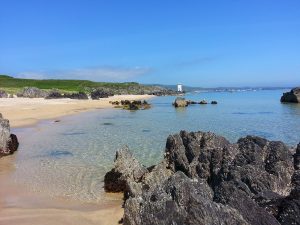
With the nickname The Queen of the Hebrides, you know you’re in for a treat when it comes to Islay. Nine distilleries and counting means Islay is also known as ‘the whisky isle’, but even if you’re not a fan of Scotch, a visit here is recommended. Wide open spaces are ripe for adventure and wildlife sightings are common; Finlaggan, the ancient seat of the Lords of the Isles, makes for an unforgettable heritage visit; and then there’s the short ferry crossing to Jura, home to distinctive peaks and more deer than you could ever hope to see.
Where to stay: There are some lovely small hotels and guesthouses, but for seamless service and amenities that will leave you feeling fully pampered, head to The Machrie, an award-winning resort that also happens to have some excellent golf courses. themachrie.com
Getting there: Again, Loganair offers flights to Islay for those who want the quickest route, while from Kennacraig on the Kintyre peninsula on the Scottish mainland, you have a choice of two routes: to Port Ellen on the south of Islay or Port Askaig on the north of the isle. The latter is best for onward travel to Jura. loganair.co.uk; calmac.co.uk
Eilean Shona
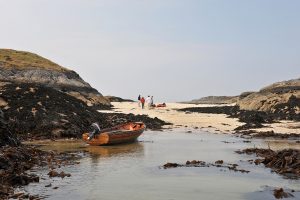
We’ve added this private island into the mix, quite simply because we imagine lots of you may dream of staying on your own Scottish isle. A tidal isle, located at the entrance of Loch Moidart on Scotland’s west coast, Eilean Shona is the supposed inspiration for JM Barrie’s Neverland. The author, who holidayed here in the 1920s is said to have been enchanted by the pristine white beaches, the moss-covered woods and the sense of freedom offered by this car-free isle.
Where to stay: There are some lovely accommodation options on the isle, including the most recent, the Sail Loft, on the east of the island, where guests can watch the sun rise above Castle Tioram each morning and retreat to their Nordic sauna in their Moroccan-style, bohemian bolthole each evening. eileanshona.com
Getting there: The island’s owner can arrange return motorised boat rides from Dorlin Pier for guests. To reach Dorlin Pier, it’s an hour’s taxi ride from Fort William for guests arriving by Caledonian Sleeper, or a three-hour drive from Edinburgh or Glasgow for those up for an adventurous drive.
sleeper.scot; arnoldclarkrental.com
Iona
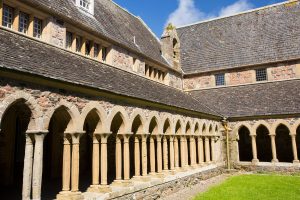
Reached from the southwestern pier of Fionnphort on Mull, Iona is a beautiful, spiritual island that should be experienced by everyone at some point in their life. It was here that St Columba set up a monastery in the 6th century and began spreading Christianity throughout Scotland, and a shrine to the saint is still present outside the more modern abbey. The old graveyard next door is where Scottish kings (including Macbeth) were buried. A pilgrimage to the White Strand of the Monks on the northeast of the isle, a snow-white beach that was once the scene of a Viking massacre, makes for a moving experience, while a boat trip to see the puffins on Staffa (www.staffatrips.co.uk) is a must.
Where to stay: The St Columba Hotel , which looks out over the Sound of Iona, is next door to the abbey and has neat rooms and a good restaurant. stcolumba-hotel.co.uk
Getting there: To reach Iona, one must first reach Mull. Buses from Mull’s main port of Craignure serve Fionnphort, from where there it is a five-minute ferry crossing to Iona.
westcoastmotors.co.uk; calmac.co.uk
Eigg
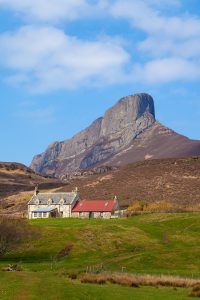
One of the aptly named Small Isles, at just three miles wide by five miles, Eigg is an ideal island escape for those who want to really get to know an island. Just south of Skye, it has some of the more famous isle’s drama in its unusually shaped An Sgùrr hill, but far fewer people. Eigg is one of the isles that is owned by islanders (rather than a rich landowner) and this community ownership can be felt in the authentic welcome you’ll receive and the openness in which islanders will share stories about their day-to-day lives on the isle and encourage visitors to explore Eigg at their own pace.
Where to stay: There is by no means lots of accommodation, so book well ahead. There are camping options and rustic sheds and bothies, but for more comfort, try Lageorna B&B or Kildonan House.
lageorna.com; isleofeigg.org/accommodation/kildonan-guest-house
Getting there: The only way to reach Eigg is by sea – either with Calmac from Mallaig on the Scottish mainland, or with Arisaig Marine, based a little further south of Mallaig. calmac.co.uk; arisaig.co.uk
Read the article in the March/April 2024 issue. Available to buy from Friday 16 February here.
Read more from Scotland Magazine:

SCOTLAND MAGAZINE
Published six times a year, every issue of Scotland showcases its stunning landscapes and natural beauty, and delves deep into Scottish history. From mysterious clans and famous Scots (both past and present), to the hidden histories of the country’s greatest castles and houses, Scotland‘s pages brim with the soul and secrets of the country.
Scotland magazine captures the spirit of this wild and wonderful nation, explores its history and heritage and recommends great places to visit, so you feel at home here, wherever you are in the world.
